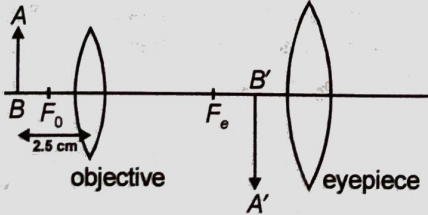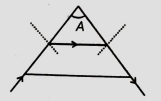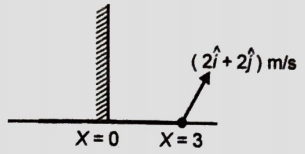A small air bubble is at the centre of a glass sphere of radius 10 cm and refractive index 1.5. The distance of the bubble from the surface, when viewed from outside the sphere, is
(1) 2.5 cm
(2) 5 cm
(3) 7.5 cm
(4) 10 cm
Focal lengths of objective and eyepiece of a compound microscope are 2 cm and 6.25 cm respectively. An object AB is placed at a distance of 2.5 cm from the objective which forms the image A'B' as shown in the figure. Maximum magnifying power in this case is

1. 10
2. 20
3. 5
4. 25
The refractive index of the material of prism is . The angle of prism A is equal to

(1) 30
(2) 40
(3) 60
(4) 90
An object is placed \(20~\text{cm}\) in front of a concave mirror of a radius of curvature \(10~\text{cm}.\) The position of the image from the pole of the mirror is:
1. \(7.67~\text{cm}\)
2. \(6.67~\text{cm}\)
3. \(8.67~\text{cm}\)
4. \(9.67~\text{cm}\)
A plane mirror is moving with velocity . A point object in front of the mirror moves with a velocity here is along the normal to the plane mirror and facing towards the object. The velocity of the image is
1.
2.
3.
4.
A candle is held \(3\) cm away from a concave mirror of focal length \(12\) cm, then the nature of the image formed by the mirror is:
1. real, inverted
2. virtual, erect
3. real, erected
4. virtual, inverted
A plane mirror is placed at x = 0 along the y-axis and an object starts moving with velocity m/s from x = 3. Relative velocity of the image in the mirror with respect to the object is:

1. 4 m/s along the -x-axis
2. 4 m/s along the +x axis
3. m/s making an angle of with the +x axis
4. m/s making an angle of with the +x axis
The angle of minimum deviation for a glass prism of refractive index \(\mu = \sqrt{3}\) equals the refracting angle of the prism. The angle of the prism is:
1. \(30^{\circ}\)
2. \(60^{\circ}\)
3. \(90^{\circ}\)
4. \(45^{\circ}\)
A diverging lens of focal length 20n cm and a converging mirror of focal length 10 cm are placed 5 cm apart coaxially. Where should an object be placed so that object and its real image coincide?
1. 20 cm away from the lens
2. 60 cm away from the lens
3. 30 cm away from the lens
4. 45 cm away from the lens
The minimum distance between a real object and screen such that a convex lens of focal length 20 cm can produce a real image on the screen is
1. 20 cm
2. 40 cm
3. 80 cm
4. 60 cm






